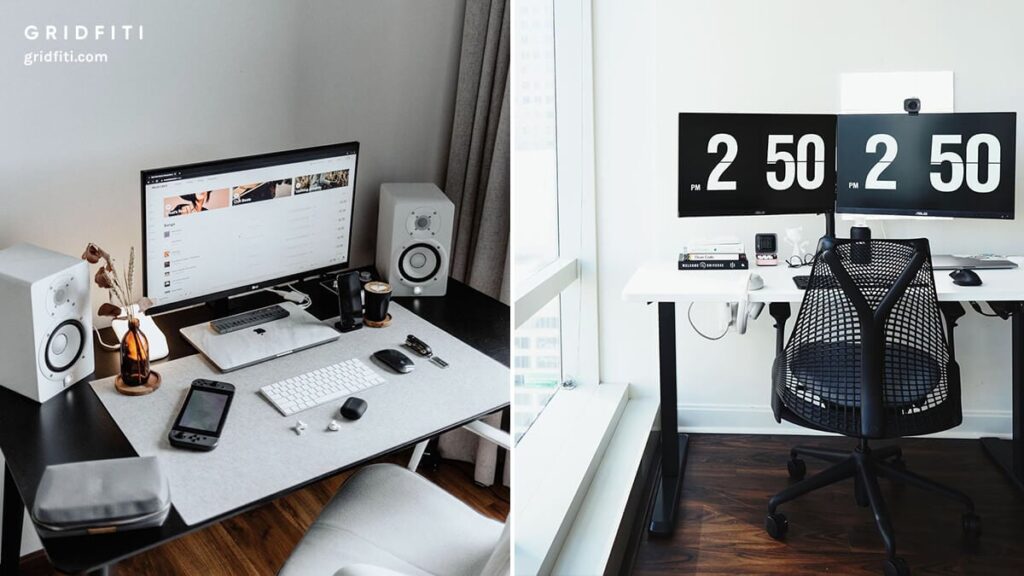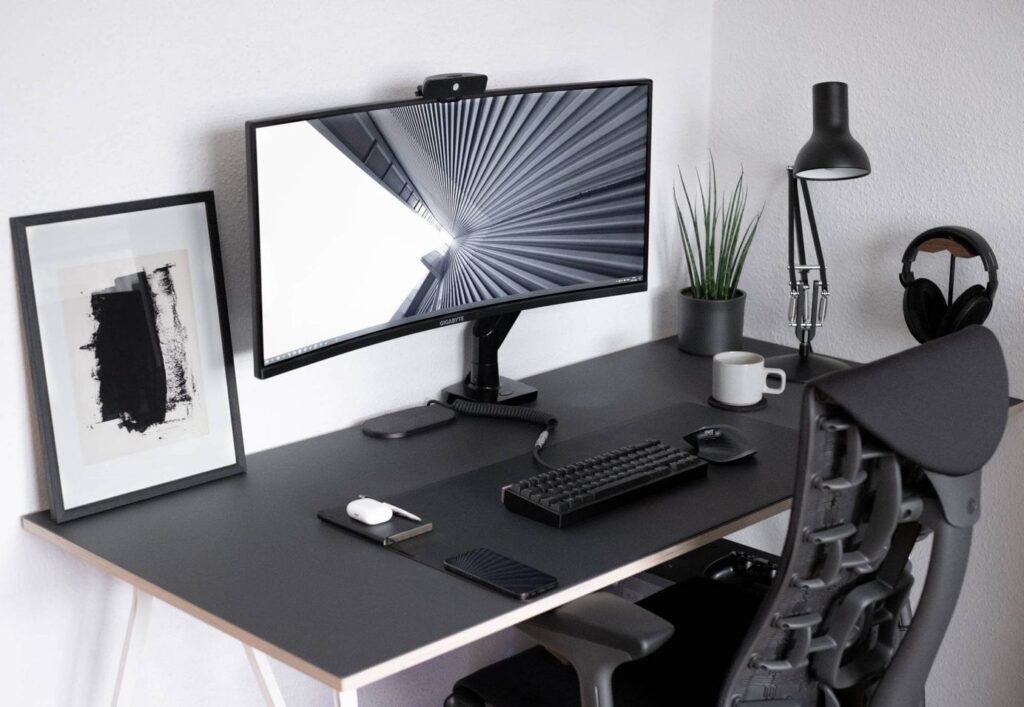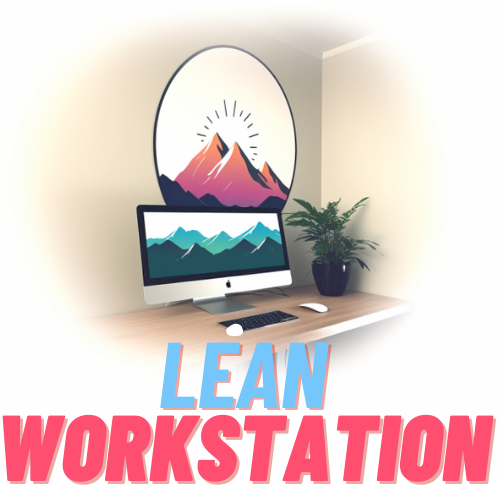
Can a minimalist setup support multiple employees in the same office? Absolutely! When it comes to creating an efficient and functional workspace, simplicity can often be the key. By embracing a minimalist approach, you can optimize your office space to accommodate multiple employees without compromising productivity or comfort.
With a minimalist setup, the focus is on decluttering and streamlining the workspace. By eliminating unnecessary items and furniture, you create a clean and open environment that promotes collaboration and efficiency. Utilize multifunctional pieces, such as desks with built-in storage, to maximize functionality in a limited space. Additionally, consider implementing flexible workstations that can be easily customized and rearranged to fit the needs of different employees. With careful planning and thoughtful design, a minimalist setup can indeed support multiple employees in the same office, fostering a productive and harmonious work environment.

Benefits of a minimalist setup
Increased productivity
A minimalist office setup can significantly enhance productivity among employees. By eliminating unnecessary clutter and distractions, employees are able to focus more easily on their work. When the workspace is clean and organized, it is easier to find the tools and resources needed to complete tasks efficiently. This boosts productivity and reduces the time spent searching for essential items.
Enhanced focus
A clutter-free environment promotes better concentration and focus. When there are fewer distractions in the office, employees can direct their attention solely towards their work. Minimalist offices are designed to create a calm and peaceful atmosphere, allowing employees to focus on the tasks at hand without unnecessary visual or auditory interruptions. This increased focus leads to higher quality work and improved overall performance.
Reduced distractions
One of the key advantages of a minimalist office setup is the reduction of distractions. Minimalist offices often have limited decor and minimal visual stimuli, which can help employees stay on task and avoid getting overwhelmed. Additionally, an organized and streamlined workflow reduces the likelihood of interruptions caused by searching for misplaced items or dealing with unnecessary paperwork clutter. By minimizing distractions, employees can stay more engaged and productive throughout the day.
Streamlined workflow
A minimalist office promotes a streamlined workflow by eliminating unnecessary steps and processes. This can be achieved through the use of efficient storage solutions, such as filing cabinets or digital organization systems. By reducing the time spent on administrative tasks and optimizing workflows, employees can spend more time on valuable and meaningful work. A streamlined workflow improves efficiency and allows for a more productive work environment.
Key elements of a minimalist office setup
Functional furniture
Functional furniture is a key component of a minimalist office setup. It is important to choose furniture that serves a purpose and meets the needs of the employees. Sleek and simple designs are often favored in minimalist offices, as they contribute to a clean and uncluttered aesthetic. Ergonomic chairs and adjustable desks are also essential to promote comfort and prevent any strain or discomfort during long hours of work.
Limited decor
Minimalist offices typically have limited decor to maintain a clean and uncluttered environment. The decor that is present is usually simple and serves a purpose, such as providing inspiration or creating a calming atmosphere. This can include artwork with clean lines and muted colors, indoor plants to add a touch of greenery, or functional accessories that serve both a practical and aesthetic purpose.
Organized storage solutions
Organized storage solutions are essential for maintaining a minimalist office. This includes having designated spaces for items such as stationery, files, and equipment. Filing cabinets, shelves, and desk organizers can help keep everything in its place and prevent unnecessary clutter. Digital organization systems, such as cloud storage or project management tools, can also be utilized to maintain a tidy and easily accessible digital workspace.
Optimized technology
Technology plays a crucial role in a minimalist office setup. Having the right tools and technology that support the workflow and needs of the employees is essential. This includes selecting devices and software that are efficient, user-friendly, and capable of integrating with other systems. Optimizing technology also involves minimizing the number of devices and cables present in the workspace to maintain a clean and organized appearance.
Creating a productive workspace
Layout and design
The layout and design of a workspace can greatly impact productivity. In a minimalist office, it is important to create a layout that maximizes space and allows for easy movement. A spacious and open floor plan encourages collaboration and minimizes any feelings of confinement. Consideration should also be given to the arrangement of furniture to ensure that employees have sufficient workspace and can easily access the tools and resources they need.
Ergonomics and comfort
Ergonomics is an essential element of a productive workspace. Chairs, desks, and other furniture should be ergonomically designed to provide optimal comfort and support for employees. This helps prevent physical strain or discomfort, allowing employees to work for extended periods without any negative impact on their health. Investing in ergonomic accessories such as adjustable monitor stands or keyboard trays can further improve employee comfort.
Lighting and color scheme
Lighting and color scheme can significantly impact the ambience and productivity of a minimalist office. Natural light is preferred whenever possible, as it creates a sense of openness and positivity. Adequate lighting should be provided throughout the office to eliminate any dark or shadowy areas that could negatively affect employee focus. Moreover, a calming color scheme with neutral tones can promote a sense of tranquility and enhance concentration.
Efficient use of space
Open floor plan
An open floor plan is a common feature of minimalist office setups. This layout encourages collaboration, communication, and a sense of community among employees. By removing physical barriers such as cubicle walls, employees can interact more easily, fostering a more collaborative and interconnected work environment. It also allows for the efficient use of space and facilitates the flow of natural light throughout the office.
Shared workstations
Another way to maximize space in a minimalist office is by implementing shared workstations. This can involve having multiple employees share a large table or utilizing hot desking, where employees do not have assigned desks but rather choose any available workstation each day. Shared workstations can foster collaboration and allow for a more efficient use of office space, particularly in environments where not all employees are present at the same time.
Flexible seating arrangements
Flexible seating arrangements are beneficial in minimalist offices, as they allow for versatility and adaptability. Instead of traditional desks and chairs, flexible seating options such as standing desks, bean bags, or modular furniture can be used. This provides employees with the freedom to choose their preferred seating arrangement based on their work tasks or personal comfort. Flexible seating promotes movement and can help prevent the negative effects of prolonged sitting.

Collaborative tools and technologies
Cloud-based software
Cloud-based software has revolutionized the way businesses operate, including minimalist offices. It allows employees to access files and collaborate on projects from anywhere, eliminating the need for physical document storage and enabling seamless remote work. Cloud-based software also ensures that employees are working with the most up-to-date information, facilitating real-time collaboration and increasing overall productivity.
Virtual communication platforms
Virtual communication platforms play a crucial role in maintaining effective communication and collaboration within a minimalist office setup. Tools such as video conferencing, instant messaging, and project management software enable employees to connect and share ideas regardless of their physical location. Virtual communication platforms also reduce the reliance on physical meetings, saving time and increasing efficiency.
Project management tools
Project management tools are vital for keeping track of tasks, deadlines, and progress in a minimalist office. These tools help streamline workflows, allocate resources effectively, and enhance team collaboration. With the ability to assign tasks, set priorities, and track progress, project management tools promote organization and ensure that projects are completed on time and within budget.
Minimizing clutter and distractions
Digital organization
Digital organization is essential in a minimalist office to minimize clutter and ensure that files and documents are easily accessible. Utilizing folder structures, naming conventions, and tags can help employees locate files quickly and avoid duplications. Implementing email management strategies, such as regularly archiving and categorizing emails, can also help maintain a clean and organized digital workspace.
Paperless systems
Going paperless is a significant step towards maintaining a minimalist office. By reducing reliance on physical documents, employees can eliminate the need for excessive storage space and reduce the risk of misplacing important information. Adopting digital document management systems, electronic signatures, and scanning technology can facilitate a paperless workflow, promoting efficiency and sustainability.
Noise reduction strategies
Minimizing noise distractions is essential for maintaining focus and productivity in a minimalist office. A quiet work environment can be achieved through the use of noise-cancelling headphones, soundproofing materials, or designated quiet zones. Encouraging respectful communication and minimizing unnecessary interruptions can also contribute to a quieter and more productive workspace.

Promoting a minimalist mindset
Clear communication
Clear and effective communication is fundamental in promoting a minimalist mindset within the office. Communicating expectations, goals, and guidelines for maintaining a minimalist workspace helps employees understand the importance of simplicity and organization. Providing regular updates and feedback, as well as encouraging open dialogue, can foster a culture of transparency and clarity.
Embracing simplicity
Embracing simplicity is at the core of a minimalist mindset. Encouraging employees to simplify their work processes, declutter their physical and digital spaces, and focus on essential tasks can lead to increased productivity and reduced stress. Recognizing and rewarding employees who embrace simplicity and find innovative ways to streamline their work can further promote a minimalist mindset throughout the office.
Optimizing workflows
Continuously improving and optimizing workflows is a key aspect of a minimalist mindset. Regularly evaluating work processes, identifying areas for improvement, and implementing streamlined solutions can help eliminate inefficiencies and unnecessary steps. Encouraging employees to share their ideas for improving workflows fosters a sense of ownership and empowerment, further promoting a minimalist approach to work.
Encouraging employee engagement
Flexible working hours
Offering flexible working hours is an effective way to promote employee engagement in a minimalist office. By allowing employees to choose their working hours within a defined framework, organizations can accommodate different work styles and personal preferences. This can enhance work-life balance and empower employees to optimize their productivity based on their individual needs and preferences.
Personalization options
While a minimalist office may have limited decor, it is still important to offer personalization options to employees. Allowing employees to add personal touches to their workstations, such as their choice of desk accessories, plants, or artwork, helps create a sense of ownership and individuality. By offering personalization options within the boundaries of a minimalist aesthetic, employees can feel more connected and engaged in their workspace.
Creating a positive company culture
Promoting a positive company culture is vital in any workplace, including a minimalist office. Building a supportive and inclusive environment where employees feel valued and recognized for their contributions fosters engagement and a sense of belonging. Encouraging teamwork, celebrating achievements, and providing opportunities for growth and development can help create a positive and motivating atmosphere within the office.

Challenges and considerations
Accommodating different work styles
One challenge of a minimalist office setup is accommodating diverse work styles. Some employees may thrive in a clean and minimalist environment, while others may struggle without personal items or a cluttered workspace. Striking a balance between minimalism and providing space for personal expression and comfort is essential to ensure that the needs of all employees are met.
Maintaining privacy and confidentiality
In an open and collaborative office environment, maintaining privacy and confidentiality can be challenging. It is important to implement strategies to protect sensitive information, such as secure file storage systems and privacy screens on computer monitors. Employing soundproof meeting rooms or designated spaces for private conversations can also help ensure a level of privacy while still promoting a minimalist office design.
Balancing minimalism with employee needs
Finding the right balance between minimalism and accommodating employee needs can be a delicate endeavor. While a minimalist office setup can have numerous benefits, it is essential to consider the preferences and requirements of individual employees. Creating a workspace that promotes efficiency and organization while respecting the different work styles and comfort levels of employees is crucial for a successful minimalist office setup.
Case studies of successful minimalist office setups
Tech companies embracing minimalism
Many tech companies have embraced minimalism in their office designs. For example, Apple’s headquarters, Apple Park, features clean lines, open spaces, and minimal decor, reflecting the company’s design philosophy. This minimalist approach fosters creativity, collaboration, and efficiency among its employees.
Startup offices with limited space
Startups often operate in small office spaces, making a minimalist setup crucial for maximizing functionality. By utilizing multipurpose furniture, implementing effective storage systems, and adopting digital workflows, startups can create efficient work environments that can accommodate growth while maintaining a minimalist aesthetic.
Remote work setups
Remote work setups can also benefit from a minimalist approach. With employees working from their own spaces, minimalism helps create a focused and productive work environment. Employees can customize their home office to align with minimalist principles and minimize distractions, promoting productivity and work-life balance.
In summary, a minimalist office setup offers numerous benefits, including increased productivity, enhanced focus, reduced distractions, and a streamlined workflow. By incorporating key elements such as functional furniture, limited decor, organized storage solutions, and optimized technology, a productive and efficient workspace can be created. Efficient use of space, collaborative tools, and minimizing clutter and distractions are also essential in maintaining a minimalist office. A minimalist mindset can be promoted through clear communication, embracing simplicity, and optimizing workflows. Employee engagement can be encouraged through flexible working hours, personalization options, and creating a positive company culture. However, it is important to address challenges such as accommodating different work styles, maintaining privacy, and balancing minimalism with employee needs. And finally, successful case studies of tech companies, startups with limited space, and remote work setups demonstrate the effectiveness of minimalist office setups in various contexts.

